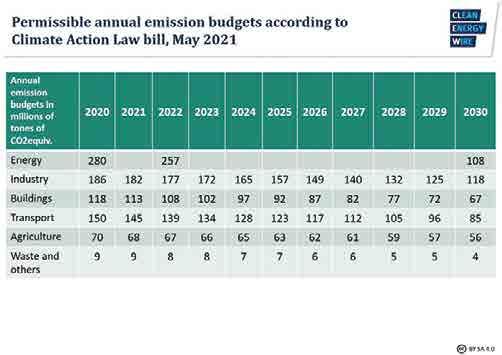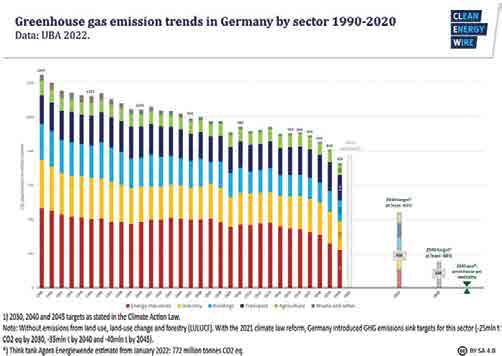
5 minute read
How close is Germany to its climate goals?
The climate focus shifts to Germany in the second instalment of our "Road to Net-Zero" series, where we look at how on track different nations are to achieving their climate goals and those laid out by the Paris Agreement.
by Steven Gislam
Germany is often cited as being one of the world leaders when it comes to renewables and the energy transition, and while green investment has vastly increased in recent years, the reality is somewhat more complicated.
While it is one of 13 nations worldwide - plus the EU - to have enshrined a climate target into law, Germany is still heavily reliant on coal, as well as natural gas. The picture is further complicated by the long-standing German aversion to nuclear power, which the former government pledged to phase out by this year.
A brief history of the 'Energiewende'
In 2010, Germany initiated its 'Energiewende' plan. Translating as "Energy Turnaround", the initial plan focused on making power systems more efficient and supplied largely by renewable sources.
The project has since evolved and Germany currently aims to become greenhouse gas neutral by 2045, a target that includes CO2, as well as other climate-damaging gases like methane and nitrous oxide. It has set preliminary targets of cutting emissions by at least 65% by 2030 compared to 1990 levels, and 88% by 2040.
The Bundestag passed its first Climate Action Law in December 2019 as part of a broader climate package that the government had decided on earlier in the year. It was based on a promise made in the 2018 coalition treaty between then Chancellor Angela Merkel's CDU/CSU alliance and the Social Democrats


to bring in "a law that guarantees compliance with the climate targets for 2030".
Changes to the Climate Action Law became necessary following a ruling by the Constitutional Court in April 2021. The top court in Germany came to the verdict that the legislation was insufficient due to a lack of details in the plans for reductions beyond 2030. "The challenged provisions do violate the freedoms of the complainants, some of whom are still very young," the court said in a statement, referring to the climate activist group that filed the complaint. "The provisions irreversibly offload major emission reduction burdens onto periods after 2030."
The legislation was amended and passed by both the Bundestag and Bundesrat in June 2021. The new law brought the net-zero date forward by five years to 2045 and laid out annual reduction targets for different sectors such as industry and transport up to 2030. The changes also "rest upon" the targets laid out in the 2015 Paris Agreement to limit global warming to below 2°C, ideally to 1.5°C.
What do the stats say?
Greenhouse gas emissions in Germany fell by 8.7% in 2020 compared to 2019 due to the effects of the lockdown following the spread of Covid-19 across Europe. The pandemic contributed to the effects of the shift to renewables, with mild weather and rising CO2 prices culminating to create the biggest drop in emissions since 1990.
Preliminary data from the Federal Environment Agency (UBA) indicated that all sectors had seen reductions in emissions, with a combined reduction of about 70 million tonnes of CO2 equivalents, bringing Germany's total emissions to 739 million tonnes.
When compared with 1990 levels, emissions in Germany are down by 40.8%, which means that it overshot its 2020 original target by 40%. Nonetheless, early data shows that emissions rose by 4% in 2021 as the country began to open up again.
Germany is the largest consumer of coal in the European Union, followed by Poland. According to Statista, over 225,000 tonnes of coal were burned in the country in 2020.
Official statistics released last year by Destatis showed that Germany’s addiction to coal had actually increased throughout 2021, unseating wind as the primary source of energy.
In the first half of the year, coal accounted for 27% of the nation’s energy mix. The increase was put down to a lack of wind during the early months of the year. Coal's share of the energy mix rose to almost 32% in the third quarter of 2021, according to Destatis, largely as a result of skyrocketing gas prices.
In January 2019, a coal-exit commission, appointed by the Merkel administration, agreed to end Germany's use of coal power stations by 2038.
In November 2021, the new coalition government comprised of the centre-left Social Democrats, the Greens, and the centre-right Free Democrats pledged to bring the date forward to 2030 - something that the previous government had ruled out.
The nuclear option
In January 2022, the European Commission revealed its new taxonomy rules which classified nuclear power as a sustainable energy source - which Berlin protested in an open letter to the EU executive.
Berlin's stance on the matter would have come as no great surprise in Brussels. Germany has long had a sceptical approach towards nuclear energy. Anti-nuclear movements sprung up in the 1970s, with the Three Mile Island disaster in the US giving the movement its first boost.
The Chernobyl disaster in April 1986 was the major catalyst for this in the country, causing widespread fear and strengthening support for the anti-nuclear movement and the Green Party.
The Fukushima disaster in March 2011 only served to cement this scepticism further, and in its wake, Chancellor Angela Merkel proposed the shutting down of eight nuclear plants for good and limiting the operation of the remaining nine to 2022.
On 31 December 2021, three of Germany's remaining six nuclear plants were closed down, with the remaining three scheduled for closure at the end of 2022. If this does happen, German energy output will be cut by around 4 GW - the equivalent of roughly 1,000 wind turbines.
The closures come at a difficult time for the energy sector and consumers. German power prices are generally high at the best of times but have soared in the past few months and this shows no sign of reversing following Russia's invasion of Ukraine.
Indeed, Germany's insistence on the phase-out of nuclear - at a time when gas prices are rising and coal is becoming increasingly unviable - is often met with disbelief and confusion by much of the rest of the continent. What makes it stand out is that it is a stance shared not just by the usual green and "leftist" parties, but right across the political spectrum. n










